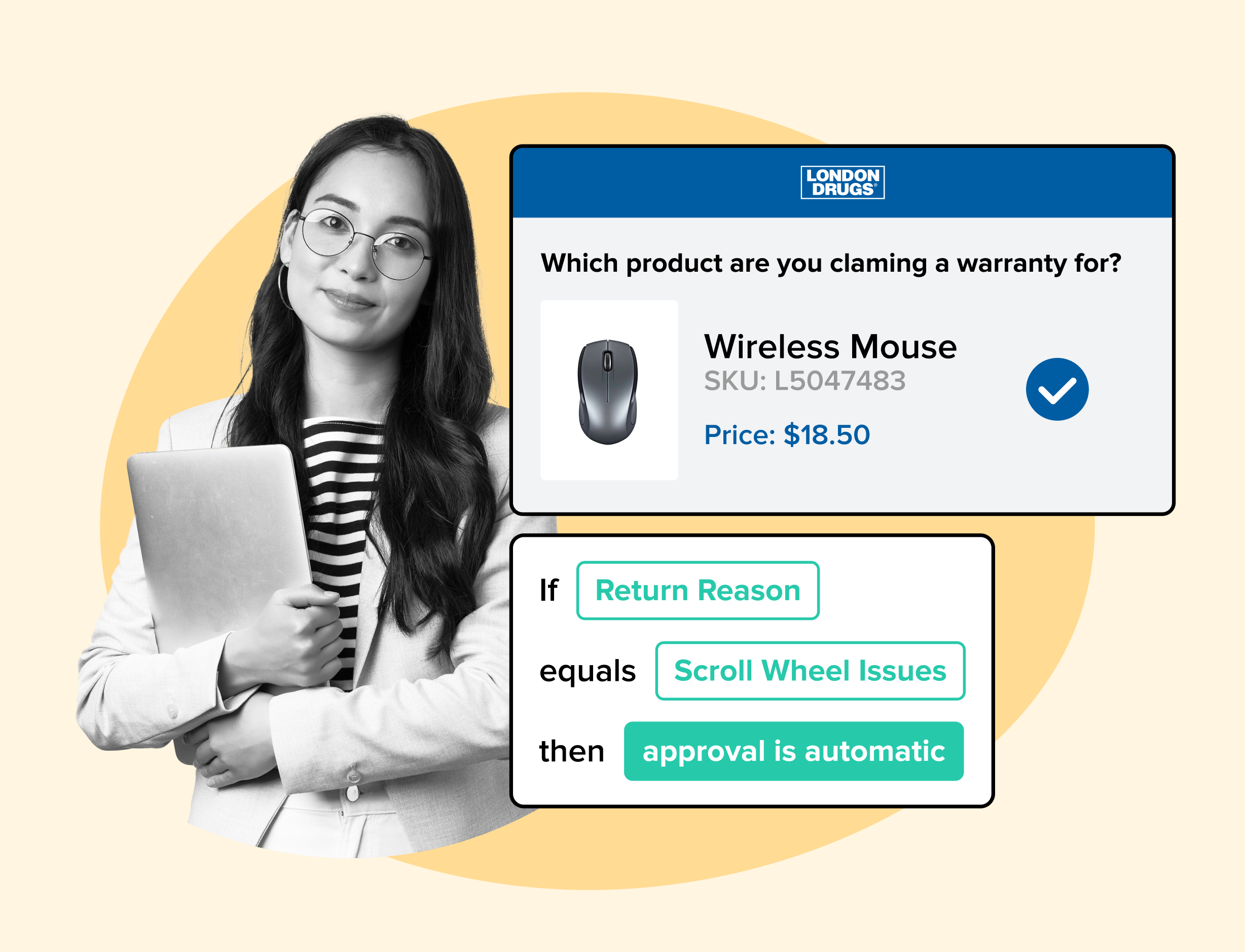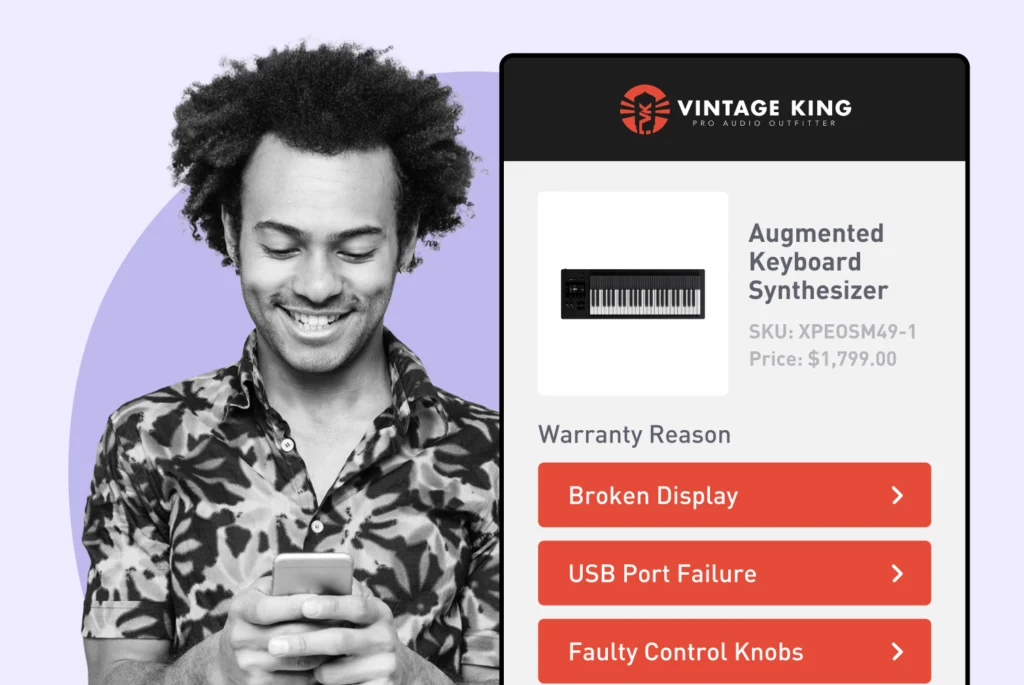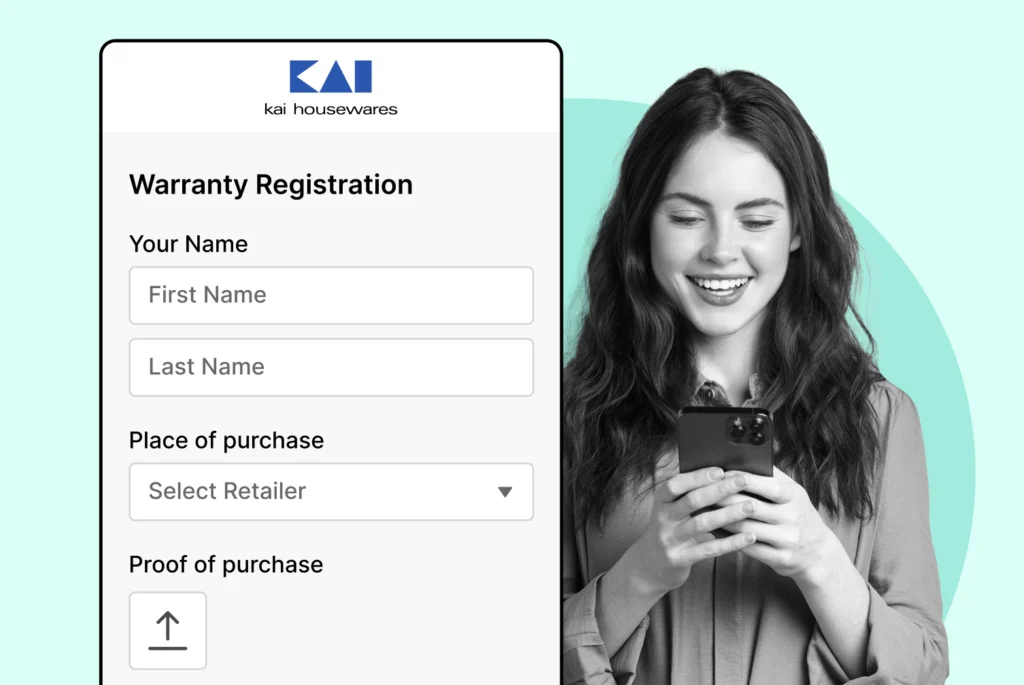
How to Create Warranty Return Flow for Fragile Goods
Create an effective warranty return flow for fragile goods to minimize losses and enhance customer satisfaction. Discover practical steps in our article.
Shipping, Tracking & Notifications
Boost customer experience and reduce support tickets
Realtime order and shipment tracking
Proactive order and shipping notifications
AI-Enhanced Discounted Labels
Predictive pre-purchase estimated delivery dates
Self-Serivce branded order tracking
Effortless experience delivered
Identify and Resolve Order Issues
Realtime order and shipment tracking
Make returns profitable and delight customers
Flexibility to define any return destinations & conditions
Simplify returns for your customers and team
Incentivize exchanges over returns
Returns management made easy for your team
Returns management made easy for your team
Easy claims and smart upsells
Understand why your customers are returning
In-Store & Curbside Pickup
Unify the online and the in-store experience
Hassle-free pickup experience for customers
In-Store dashboard to keep operations streamlined
In-Store and Online orders unified
Drive foot-traffic to your stores
Shipping, Tracking & Notifications
Boost customer experience and reduce support tickets
Realtime order and shipment tracking
Proactive order and shipping notifications
AI-Enhanced Discounted Labels
Predictive pre-purchase estimated delivery dates
Self-Serivce branded order tracking
Effortless experience delivered
Identify and Resolve Order Issues
Realtime order and shipment tracking
Make returns profitable and delight customers
Flexibility to define any return destinations & conditions
Simplify returns for your customers and team
Incentivize exchanges over returns
Returns management made easy for your team
Returns management made easy for your team
Understand why your customers are returning
In-Store & Curbside Pickup
Unify the online and the in-store experience
Hassle-free pickup experience for customers
In-Store Dashboard to keep operations streamlined
In-Store and Online orders unified
Drive foot-traffic to your stores
Boost customer experience and reduce support tickets
Realtime order and shipment tracking
Proactive order and shipping notifications
AI-Enhanced Discounted Labels
Predictive pre-purchase estimated delivery dates
Self-Serivce branded order tracking
Effortless experience delivered
Make returns profitable and delight customers
Flexibility to define any return destinations & conditions
Simplify returns for your customers and team
Incentivize exchanges over returns
Returns management made easy for your team
Equip your team for precise return checks.
Understand why your customers are returning
Unify the online and the in-store experience
Hassle-free pickup experience for customers
In-Store Dashboard to keep operations streamlined
In-Store and Online orders unified
Drive foot-traffic to your stores
Find the answer to all your questions
Take a step by step trip through our functionality to see how we can improve your ecommerce processes.
Explore the most comon questions about WeSupply
Calculate the ROI that WeSupply can bring you
Request a no strings attached review of your current shopping experience and missed conversion opportunities
Read actionable articles on how to optimize your post-purchase experience and decrease support tickets
Get inspired by stories of how our customers implemented an effortless post-purchase experience
Wondering if WeSupply is a good fit for you? Read through our use cases to see how we can help you increase conversion & improve CX!
A Deep Dive into Top Companies' Order Tracking & Returns Strategy
Find the answer to all your questions
Explore the most comon questions about WeSupply
Calculate the ROI that WeSupply can bring you
Request a no strings attached review of your current shopping experience and missed conversion opportunities
Take a step by step trip through our functionality to see how we can improve your ecommerce processes.
Read actionable articles on how to optimize your post-purchase experience and decrease support tickets
Get inspired by stories of how our customers implemented an effortless post-purchase experience
A Deep Dive into Top Companies' Order Tracking & Returns Strategy
Wondering if WeSupply is a good fit for you? Read through our use cases to see how we can help you increase conversion & improve CX!

As ecommerce businesses grow, the challenge of managing warranty returns becomes more than just an operational hurdle—it becomes a vital piece of the customer experience. Whether you’re handling a few dozen claims a month or thousands, offering warranty returns at scale requires careful planning, smart automation, and a deep understanding of your legal and customer obligations. When done right, it can become a powerful brand differentiator. Providing clear and accessible warranty information is essential, as it helps customers understand their coverage and builds trust in your brand.
In this guide, we’ll walk you through everything you need to know about scaling your warranty return process—from foundational policies and automation tools to compliance strategies and future trends—so you can streamline operations without sacrificing service quality.
Today’s shoppers expect fast, no-hassle support when something goes wrong—and warranty returns are often where brands prove whether they truly care. If the process is frustrating or slow, it can cost you more than just time—it can lose you a customer for life.
For growing businesses, especially those selling across multiple channels like Amazon, Walmart, or their own website, the volume and complexity of warranty claims can spike quickly. Warranties vary depending on the manufacturer and the type of products sold, which increases the need for scalable solutions. Without a system that scales, your team can become overwhelmed, leading to delays, mistakes, and unhappy customers.
Offering warranty returns at scale is not just a reactive service—it’s a proactive strategy for customer retention, quality assurance, and operational efficiency.
Let’s start with the basics. A warranty is a promise from a manufacturer or seller that a product will function as expected for a certain period of time. If the product fails due to defects in materials or workmanship during that period, the seller agrees to repair, replace, or refund it.
Most warranties fall into two categories:
Express warranties, which are explicitly stated (often in product descriptions or packaging).
Implied warranties, which include legal standards like “merchantability” (the product does what it’s supposed to) and “fitness for a particular purpose.”
In addition to express and implied warranties, there is the manufacturer’s warranty, which specifically covers defects in material and workmanship as provided by the manufacturer. The manufacturer’s warranty often differs from other warranties, such as store or third-party warranties, in its scope, duration, and the conditions that may void coverage. Other warranties may include extended service plans or additional protection options that supplement or differ from the manufacturer’s warranty.
Warranties can vary greatly. Some offer full refunds or exchanges, while others cover only repairs. There is an important distinction between full and limited warranties: a full warranty provides comprehensive coverage, while a limited warranty—one of the most common types—specifies restrictions on duration, parts, or types of service. Some may exclude accidental damage or misuse. That’s why it’s essential to clearly communicate warranty terms, conditions, limitations, and exclusions to customers—before and after purchase.
Transparency builds trust and reduces disputes. Ensure this information is visible on product pages, in order confirmation emails, and in your return portal.
Note: All important warranty details should be clearly noted and made available to customers upon request. This ensures compliance and helps customers make informed decisions.
A strong return policy is the foundation of an efficient warranty return process. At scale, vague or inconsistent policies lead to confusion, friction, and inefficiencies.
First, clearly outline what the warranty cover includes, the duration, and all material conditions. Specify that the warranty does not extend to damage caused by misuse, unauthorized repairs performed, or failure to follow instructions. The company is the sole judge of whether a defect or failure is covered. Only the original purchaser is eligible for warranty service; the warranty does not apply to products purchased separately or for resale. Replacement parts may be provided for eligible warranty claims, but repairs performed by unauthorized parties may void the warranty. The warranty does not cover incidental or consequential damages, and consequential damages are excluded to the fullest extent permitted by law.
Next, implement a Return Merchandise Authorization (RMA) process. Customers must request a return authorization and obtain a return authorization number before sending any returned item. A completed rma form must be included in the return package. All requests must be made within the applicable warranty period. Returned items must be in the same condition and new condition as received, including all original packaging, manuals, and contents, to be eligible for a full refund or exchange. The company will only accept returns that meet these requirements. A re-stocking fee or handling charges may apply if the returned item is not in original packaging or new condition. Items that do not meet these criteria may not be accepted for return or exchange.
Original shipping, return shipping fees, and handling charges are non-refundable, and the customer is responsible for paying these costs unless the return is due to a confirmed defect. Freight and freight charges related to shipment and delivery are the responsibility of the customer unless otherwise specified. The company will credit the original method of payment for approved refunds, less any applicable fees.
Also, clarify who pays for return shipping. Many businesses offer prepaid labels if the issue is a confirmed defect, while others ask customers to cover shipping unless the company is at fault. Be consistent and fair in your approach. The customer is responsible for paying all applicable shipping, return shipping fees, freight, and handling charges unless otherwise stated.
Finally, document everything. Keep accurate records including serial numbers, purchase dates, return reasons, repair or replacement details, and communications with the customer. Such goods and the device and material conditions will be inspected upon receipt to ensure compliance with the policy. This data helps resolve disputes and identify patterns for improvement.
For any questions about the return process, warranty cover, or to request a return authorization, please contact us or contact customer service.
Scaling a manual warranty process is like trying to fill a swimming pool with a bucket. It may work at first, but as your volume grows, it becomes unsustainable fast.
Automation is a game-changer. Research shows that manual warranty claims can take up to 15 minutes per case and cost around $5 each. Multiply that by hundreds or thousands of claims, and it’s easy to see how costly inefficiencies can be. Automated systems can save more than 40 hours of labor per week and reduce refund rates by up to 30%.
Here’s how automation helps:
Self-Service Portals: Let customers initiate and track warranty claims online using just their order number and email. They can upload photos, describe the issue, and view status updates without contacting support.
Auto-Approvals: Use logic-based workflows to automatically approve common claims like broken zippers or dead electronics on arrival.
Integrated Tools: Sync your warranty platform with tools like Gorgias, Zendesk, or your CRM to streamline communication and reduce back-and-forth.
Real-Time Updates: Notify customers of every stage—from “Claim Received” to “Replacement Shipped”—to manage expectations and minimize inquiries.
Inventory and Shipping Integration: Connect to your warehouse or fulfillment system to auto-generate shipping labels and track replacement stock.
Brands like Groove Life and goodr are prime examples of automation success. Groove Life increased its daily service capacity by 60%, while goodr seamlessly handles 3,000–5,000 monthly returns without burdening their support team.
No matter how efficient your process is, it must comply with consumer protection laws—especially in markets like the European Union. Businesses are responsible for providing clear warranty information and warranty service in compliance with applicable laws, ensuring that consumers have access to all necessary details and support.
Note: It is essential to understand and fulfill your legal responsibilities regarding warranty information and warranty service to avoid potential liabilities and ensure transparency with consumers.
Consumers have a minimum 2-year legal guarantee for faulty goods.
A 14-day “cooling-off” period allows returns for any reason on distance sales (e.g., online orders).
The first remedy must be repair or replacement, free of charge. If that’s not possible, a refund may be issued.
Sellers must cover shipping, labor, and parts during the repair/replacement process.
It’s also common for businesses to offer commercial warranties on top of legal guarantees. These can provide extra peace of mind, but must never replace the consumer’s legal rights. You’re legally obligated to clarify this distinction.
For businesses unsure about the rules, tools like the Consumer Law Ready portal and Your Europe offer clear guidance. Legal compliance isn’t just about avoiding penalties—it’s about building trust and ensuring your global customers feel protected.
Selling on Amazon, Walmart, eBay, or your own site? Congratulations—but now your warranty process needs to be even more robust.
Each channel may have different return rules and data structures, making it hard to centralize and scale your warranty operations. In fact, third-party marketplace claims can account for up to 25% of all warranty requests.
Here’s how to stay on top of it:
Create product registration programs that allow customers from any channel to register their product directly with you. This gives you visibility into who owns what and where it was purchased.
Unify claim intake through a centralized system or portal, regardless of where the purchase originated.
Connect systems like inventory management, shipping, and CRMs to ensure smooth handling across platforms.
For equipment such as scales, ensure that calibration weights are included with the returned item to allow for proper inspection and warranty processing.
Also consider your logistics setup. Automate warehouse tasks like claim verification, status updates, and shipping label generation. If you’re operating at scale, regional return hubs can speed up processing and reduce shipping costs.
Automation and legal coverage are vital—but customer experience is where brands win or lose.
Start by making your warranty process simple and accessible. A well-designed self-service portal is the cornerstone. Customers should be able to log in, file a claim, upload photos, and track progress—all without contacting a human. If you have questions or need assistance at any point, please contact our support team for help.
Then, personalize the experience. Segment your customers by Customer Lifetime Value (CLV) and offer priority service to your most loyal buyers. For example, only eligible high-CLV customers might get same-day approval or expedited shipping.
Clarity is key. Don’t leave customers in the dark. Send real-time SMS or email updates at each stage. Set clear expectations on resolution timelines and what’s required from the customer.
Lastly, be flexible. Offer exchanges instead of refunds when possible, or store credit for customers nearing the end of their warranty period. These small touches can turn a negative situation into a loyalty-building moment.
If you have any questions about your warranty claim, please contact us.
Warranty claims aren’t just costs—they’re insights. When tracked and analyzed properly, return data can help you improve product design, packaging, supplier accountability, and customer satisfaction.
Start by identifying root causes. Are most returns due to damage during shipping? A manufacturing flaw? Misuse from unclear instructions? Analyzing material quality and device performance can help pinpoint recurring issues and improve future products.
Data from platforms like ReturnLogic shows that around 60% of warranty returns are for damaged or defective products. By resolving the underlying issue, you can reduce future claims and cut costs.
Also, use claim data to enhance marketing and retention. Customers who register their product for warranty can be added to your email list, receive helpful tips, and be offered personalized promotions—driving up CLV.
Advanced teams even tailor service levels based on warranty claim history, region, or product category. The more granular your analysis, the more proactive and profitable your operations become.
Scaling warranty returns doesn’t happen overnight. Here are a few roadblocks businesses often face:
Many businesses wait too long to switch from spreadsheets and email-based claims. Start small by automating your highest-volume SKU or product line, then expand gradually.
Different countries, different laws. A centralized, compliant warranty policy platform can help standardize your terms while allowing for regional customization.
No matter how efficient your backend is, customers want fast and empathetic support. Ensure human help is always available when automation falls short—especially for emotionally charged or high-value cases.
Collecting product registration or claim info? Make sure your tools are compliant with GDPR, CCPA, and other privacy laws to protect customer data and avoid fines.
Simplify Warranty Claims for Your Customers and Support Team
Book a quick call with our experts to see how WeSupply can help you: simplify the Warranty Claim experience with just a few clicks, reduce customer service calls and manual processing, notify your customer about their refund, automate returns and reduce user error.
As your ecommerce business grows, handling warranty returns at scale can feel like a juggling act—but with WeSupply, it becomes a streamlined, customer-first process that fuels loyalty and long-term growth.
Whether you’re managing claims across Amazon, Walmart, or your own site, WeSupply offers a complete platform to help you automate operations, personalize experiences, and unlock new revenue opportunities—all while making your post-purchase journey unforgettable.
Customer Identification & Onboarding
Collect key customer details (name, email, phone, proof of purchase) using smooth autofill forms. Know where products were purchased and personalize the journey from day one.
Multi-Channel Claim Consolidation
Centralize warranty claims from all your sales channels, including marketplaces and retail partners, so nothing falls through the cracks.
Real-Time Notifications & Tracking
Keep customers informed with automated email and SMS updates at every stage—from claim received to replacement shipped—reducing anxiety and support inquiries.
Digital Product Resources & Onboarding
Provide self-service guides, how-to videos, and care instructions to reduce support calls and prevent unnecessary returns—accessible anytime with a simple rescan.
Extended Warranty Sales
Offer extended protection plans (2 or 5 years) covering accidental damage, expedited replacements, and free shipping—driving high-margin revenue directly from registered customers.
Upsell Opportunities During Claims
Recommend compatible accessories and service plans during warranty claims to increase average order value and customer satisfaction.
Product Reviews Collection
Encourage verified reviews and boost product ratings by prompting registered customers to share their feedback—helping future buyers and increasing conversions.
Service Alerts & Maintenance Reminders
Stay top-of-mind with automated check-up reminders that extend product life and reinforce brand loyalty.
Warranty Eligibility Rules & Product Recall Management
Easily define warranty conditions, automate eligibility checks, and manage product recalls with clear visibility and compliance.
Data-Driven Product Improvement
Analyze claim reasons, photo uploads, and failure trends to pinpoint design or manufacturing issues. Use these insights to reduce future claims and enhance product quality.
Optimize Reverse Logistics
Automate the backend of returns—repairs, replacements, shipping, and restocking—to increase efficiency and lower costs without sacrificing customer satisfaction.
GDPR & CCPA-Compliant Data Handling
Protect customer data and ensure compliance with built-in security and privacy features.
With WeSupply, warranty returns become more than just problem-solving—they become loyalty-building moments, revenue-generating opportunities, and strategic insights for your entire business.
Whether you’re just beginning to scale or managing thousands of monthly claims, WeSupply equips your team with the tools to automate, personalize, and monetize your warranty process—turning every post-purchase experience into a brand win. Book a demo now!
Warranty return management is evolving quickly. Here’s what forward-thinking brands are focusing on:
CLV-Based Prioritization: Tailor service speed and benefits to your most valuable customers.
Transparency Tools: Some European retailers now show return rates and warranty scores to boost shopper confidence.
Open API Platforms: Seamless integrations between your warranty system, CRM, and warehouse tools are now possible with real-time APIs.
Sustainability: Expect more emphasis on eco-friendly practices like refurbishing returned products or offering digital warranty documentation to cut waste.
The businesses that stay ahead of these trends will be best positioned to turn warranty returns from a cost center into a revenue driver.
Scaling warranty returns doesn’t have to be a headache—with WeSupply, it becomes a strategic advantage. By combining automated RMAs, real-time claim tracking, self-service portals, and QR code-based product registration, you can streamline every touchpoint while identifying real customers—even from third-party marketplaces. WeSupply also helps you boost engagement through personalized follow-ups, extended warranty offers, accessories, service reminders, and verified review collection. Plus, with compliance-ready data handling and deep product insights from claim analytics, you not only resolve issues faster but improve product quality and customer loyalty. In the end, WeSupply helps you do more than process returns—it helps you build trust, unlock revenue, and deliver exceptional post-purchase experiences at scale.
Combat inconvenience with proactivity & self service
Book a quick call with our experts to see how WeSupply can help you make returns easy for your customers with a beautiful, self-service solution that makes their experience easier while also providing new ways to lower costs and earn back revenue.
1. How can I manage warranty returns for multiple sales channels like Amazon and Walmart?
Use a centralized warranty portal that collects claims across all platforms. This avoids fragmentation and ensures a consistent customer experience.
2. What’s the best way to automate warranty returns?
Implement self-service portals, auto-approval workflows, and real-time notifications to reduce manual workload and speed up resolutions.
3. Who pays for return shipping in warranty claims?
Typically, the customer pays unless the issue is a confirmed defect. Clearly state shipping responsibilities in your return policy.
4. How does WeSupply automate warranty return workflows?
WeSupply offers rule-based RMA automation, allowing you to auto-approve common issues and reduce support time.
5. Can WeSupply consolidate warranty claims from different channels?
Yes. WeSupply centralizes claims from Amazon, Walmart, DTC sites, and more into one unified dashboard.
6. Does WeSupply support QR code-based product registration?
Absolutely. WeSupply enables customers to register products using QR codes, even from third-party marketplaces.
7. Does WeSupply have an Official Shopify App?
Yes. WeSupply has an Official Shopify App. You can download it and start integrating with your Shopify Store.
8. Does WeSupply have an official Magento extension?
Yes, WeSupply has an official extension for Magento. The WeSupply x Magento integration allows for automating order tracking experiences, reducing customer inquiries, automating shipping email and SMS notifications, and providing a fully branded order tracking experience
9. Does WeSupply have an official BigCommerce App?
Yes, WeSupply has an official BigCommerce App. You can integrate WeSupply with your BigCommerce store to improve your post-purchase customer experience.
Learn How To Create Successful Post Purchase Email Campaigns
Build an effective post-purchase email flow that helps you increase customer satisfaction and drive revenue growth!

Create an effective warranty return flow for fragile goods to minimize losses and enhance customer satisfaction. Discover practical steps in our article.

Discover effective strategies to combat warranty fraud and protect your business. Learn best practices for prevention and safeguard your assets. Read more!

Master the essentials of electronics warranty return management with our comprehensive guide. Streamline your process and reduce hassle. Read more now!

Learn effective strategies for offering self-service warranty returns that enhance customer satisfaction and streamline your process!

Discover how warranties can boost customer loyalty and drive repeat purchases in online stores. Learn effective strategies to enhance your sales. Read more!

Discover the top 10 ecommerce warranty management software solutions to enhance your business efficiency and customer satisfaction. Read the article now!

Discover key insights from NRF 2024 to enhance your retail strategy. Learn actionable tips for success and stay ahead in the competitive market. Read more!

Learn effective strategies for offering self-service warranty returns that enhance customer satisfaction and streamline your process!

Simplify your warranty claims process with Shopify automation. Discover practical strategies to streamline and enhance efficiency!